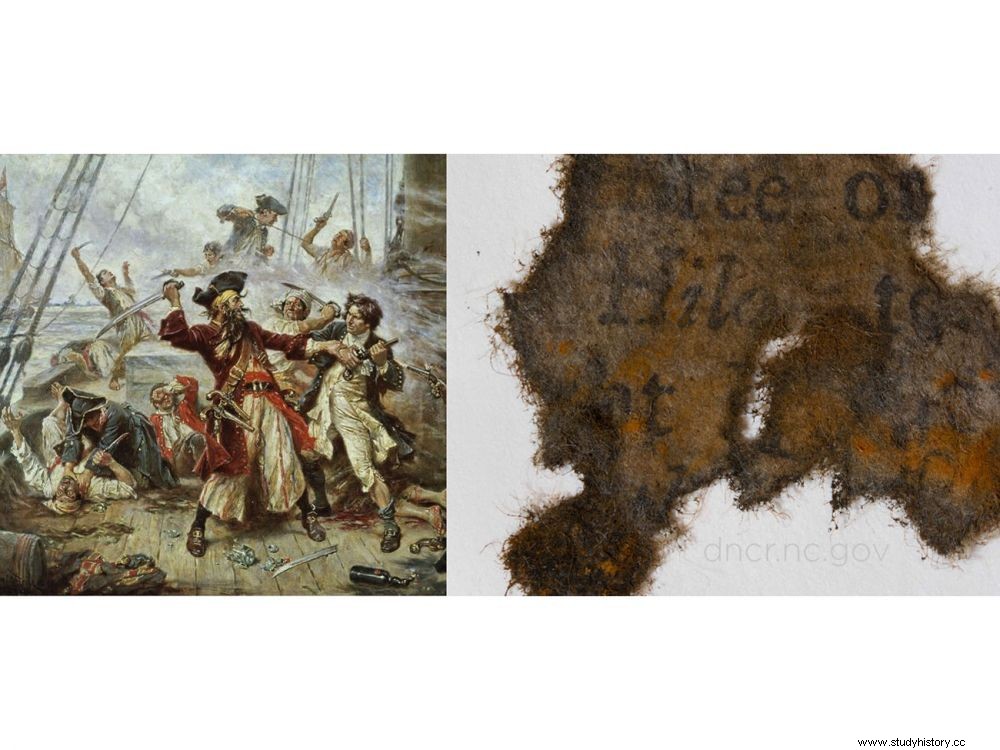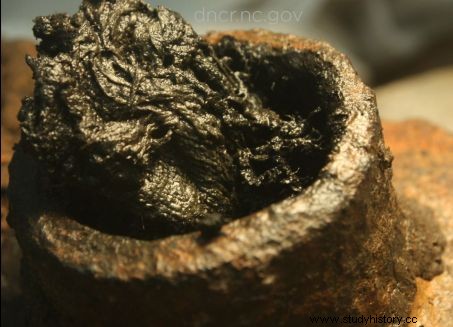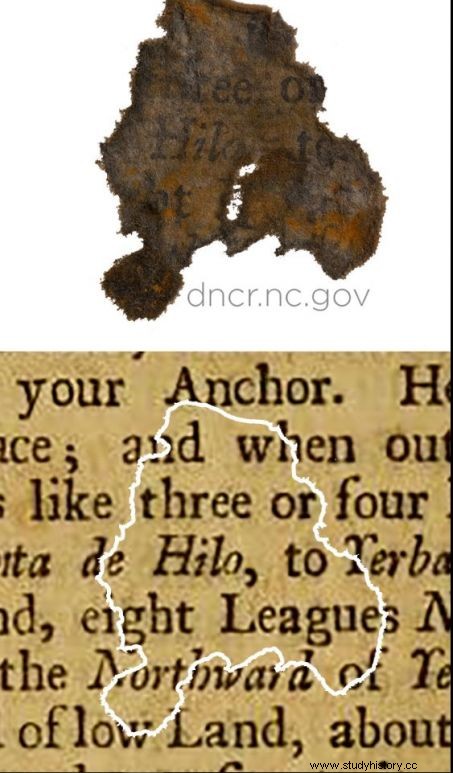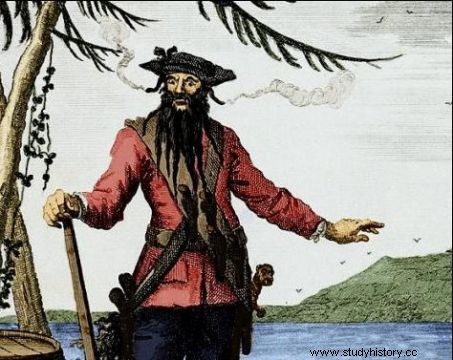After three centuries spent under the sea, fragile fragments of paper from the most famous of Blackbeard's boats have been saved. To (re)discover on the occasion of the 300th anniversary of the death of the famous pirate, on November 22, 1718.

The capture of the pirate Blackbeard by Lieutenant Maynard, at the site of Ocracoke Bay, in 1718. As well as one of the fragments of 18th century paper discovered on the wreck of Queen Ann's Revenge, his ship.
Pirates are known to sing with a bottle of rum in hand... but were they reading? Thanks to a recent discovery, researchers have acquired a certainty:if they had no particular taste for reading, they used pages of books to load their weapons! As proof, the 16 tiny fragments of paper recovered in 2016 among the muddy remains of elements of firearms recovered from the wreck of the Queen Anne’s Revenge , the flagship of one of the most famous British pirates of the 17th-18th century, Edward Teach, better known as Blackbeard* (read box ).
After three centuries spent under water in the wreckage of the building discovered in 1996 off the coast of North Carolina (United States), these confetti which generally decompose very quickly at the bottom of the sea, could be saved from destruction. total. This is thanks to the combined efforts of the conservators of the Laboratory of Natural and Cultural Resources in Greenville, North Carolina, associated with experts in paper conservation, and researchers from the University of Delaware (Newark) of the Winterthur program specializing in inks and texts.
Silt-covered paper fragments found inside a gun breech chamber recovered from the wreckage of Blackbeard's ship. ©Courtesy of the North Carolina Department of Natural and Cultural Resources
'These piles of paper and rags were discovered in the breech chamber of a firearm" , explains Erik Farrel, curator at Queen Anne’s Revenge Lab, joined by Sciences et Avenir. It was during the cleaning of the metal block covered with concretions that the fragments of paper undoubtedly used as wad were found at the rear of the weapon, behind the barrel, where they ensured a better seal of the mechanism of explosion during shooting.
Once the disintegration of these fragile documents was checked, the researchers found that printed text was still visible on seven of the saved samples! But would the few words identified make it possible to identify the original text? A challenge met hands down.
Among the 16 paper fragments rescued and restored, the word "Hilo" led researchers to find the original text, a book by Edward Cooke, dated 1712. © Courtesy of the North Carolina Department of Natural and Cultural Resources
Like detectives, the scientists set to work for months. After isolating several words, especially "Hilo" , a town in Peru, which enabled them to determine that these passages were from a first edition of Journey to the South Sea * by Captain Edward Cooke published in 1712. An account which described the expedition led by the English captain Woode Rogers, which culminated in the rescue of a Scottish sailor named Alexander Selkirk, found on the island Juan Fernandez, where he had been abandoned for four years and twelve and days. In other words, the story that will be at the origin of the famous novel Robinson Crusoé , published by Daniel Defoe in 1719!
This is the first time that the remains of books have been found on a pirate ship, especially that of the terrible Blackbeard! Texts to make the powder speak!
* "A Voyage to the South Sean and Round the World, Perform’d in the Years 1708, 1709, 1710, and 1711" , Edward Cooke.
Engraving of Pirate Blackbeard, Captain of the Queen Ann's Revenge. ©Courtesy of the North Carolina Department of Natural and Cultural Resources.
Blackbeard, a mythical pirate
Known as Blackbeard, the British pirate Edward Teach, probably born around 1660 and said to be educated, had a terrible reputation. "He adorned his beard with ribbons and strands of hemp, while carrying a saber and six pistols slung over his shoulder" , says historian Philippe Hrodej, lecturer at the University of South Brittany. It raged between the Caribbean and the Atlantic coast of North America. Among his most prestigious captures is a Nantes slave ship, the Concorde . Blackbeard renames it to Queen Ann's Revenge , adds 20 cannons, and makes her the most powerful ship in her fleet with over 300 crew! Thanks to this frigate, he seizes many merchant ships, which he most often burns after looting them. It seems that Blackbeard deliberately caused the Queen Ann's Revenge to fail. in the shallow waters of Beaufort Cove (North Carolina) to keep only a small crew. He will thus abandon many "Brothers of the Coast" on a deserted coast in order to share with as few men as possible a treasure which he said was known only to the Devil alone... Edward Teach, whose head is put at a price , would be killed during a punitive expedition mounted against him by the Royal Navy on November 21, 1718. His head would be exposed, hanging from the top of a yardarm.
Find out more:
History of pirates and corsairs from antiquity to the present day , Philippe Hrodej, Gilbert Buti, CNRS Editions, 2016



